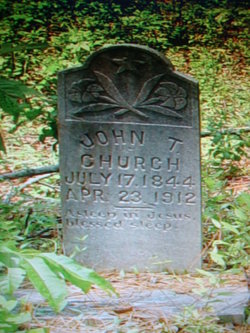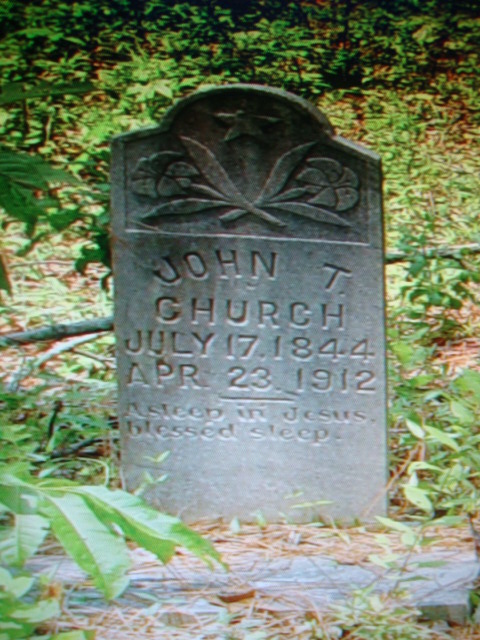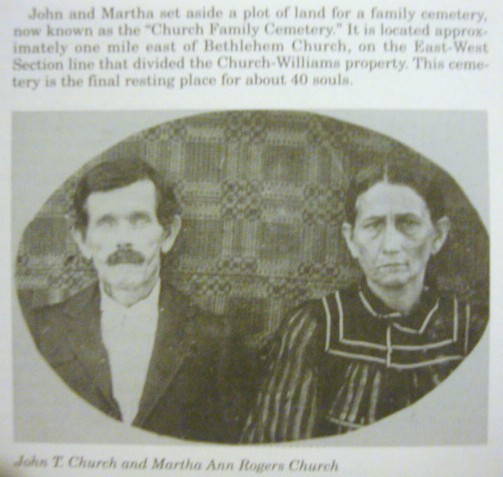The following information was provided by Perry County Records, Family records of Billy Hughes, Mona Cochran Mcpherson and Winford McFarland's
JOHN THOMAS CHURCH CIVIL WAR RECORD
John Thomas Church enlisted in the Army at age 20 in Marion on 18 March 1862 as a Private in Company "K", 11th Alabama Infantry. This Company was assigned to the Army of Northern Virginia and as such most of the battle came nine months late at Fredericksburg, Virginia on the -11-13 of December 1862. The South on this battle had a loss of 5,300 men while the Union lost 12,600 men.
Other battles that followed were: The Wilderness 5-6 May 1864,Hanover Junction 24 May 1864, Atlee's Station on 1, June 1864, Turkey Ridge 3-12 June 1864, Wilcox Farm 22 June 1864, Kautz and Wilson 29 June 1864, The Crater 15-20 July 1864, Whites Tavern 16 August 1864 and Reams Station 25 August 1864 ( end Note: His Military record listed Whites Tavern, Which is at Deep Bottom Virginia in the dismal swamp, as a battle where he was captured, but it also lists Reams Station as a battle he was in).
The wilderness battle was fought in an area so thick with underbrush and trees. During this battle they received emergency orders to proceed to Spotsylvania where a break in the defenses was probable. After a forced march they arrived on the night of 9 May 1864 and fought one of the fiercest battles of the entire war. Their efforts stopped the advance of the Union Forces who lost 17,000 men, while the South lost 3,000. Historians have written that blood ran like water and the streams were all red from the blood. Union soldiers were piled four deep. It became known as : The Bloody Angle".
The Crater Battle was fought a short distance from Petersburg where the South had established a solid line of defense around the area. The Union brought in coal miners from Pennsylvania and had them dig a tunnel about 500 feet long under the front line defense. Here they placed 8,000 pounds of black powder at the end and exploded it. The explosion was so great that it created a giant crater between the front line and the reserve lines of the South.
Arriving at the edge of the crated, they slid down into it, intending to get out on the other side. They found the wall toll steep and the dirt too loose, making them slide back. They were trapped. The C.S.A soldiers crawled up to the edge and placed their hats on the end of their rifles, then pushed them up for the trapped soldiers to see, thinking it was an attack, began to fire wildly at the hats, After the first volley, the C.S,A solders went over the top and down into the crater before their opponent had time to reload. Here they were able to overcome the superior forces of the North. This is the first battle where black soldiers were used against the South. During the hand-to-hand fighting, the blacks became disorganized and ran in every direction trying to escape to their own lines for protection. In this battle the Union had 4,000 casualties and the South 1,500.
The battle at Ream's Station was fought with very little ammunition and a shortage of men but the C.S.A. forces were still very strongly resisting. In this battle the Union lost 2,742 men but the C.S.A. forces were still strongly resistance. In this battle the Union lost 2.742 men, while the South lost 814.
His next and lost battle was at Whites Tavern in the dismal swamp at Deep Bottom Virginia. All the men were weary, half sick and hungry. Their ammunition was almost all gone and they could no longer hold out against a fresh, fully equipped enemy. It was here that he was captured and taken to Point Lookout, Maryland as a POW. There he was interned in a camp built to hold 10,000 prisoners but 20,000 were already there. His confinement was with short rations and in filthy conditions. He remained here until the war was over and released on 13 February 1865 in an exchange of prisoners and paroled.
General Lee questioned General Grant about the disposition of privately owned horses. General Grant's reply was the " All the men who claim a horse or mule should take the animals home with them to work their little farms."
So it ended one of the most infamous periods of out history. There were no winners only losers on both sides. The needless loss of life was far grater than all other wars combined.
Returning weary and half sick to his home in Perry County Alabama, a place he had not seen or received any news of in three years (neither of his parents could read or write). He found many found many disheartening changes. Some relative and friends had died, some had moved away and life in general looked very bleak. Determined to overcome all the misery that he had encountered he set about trying to help his family and forget the horrors of war.
For a time he lived at home with his parents and worked their farm, then later hiring out as a farm laborer. Wanting to get married and start his own life, he married Martha Ann Rogers in July 1870. An application for a grant to homestead 140 acres of land adjoining the Rogers farm was granted and they started building their life together.
He often stated in later years that he never liked the Army life and thought when he joined it would all be "sugar in the gourd", but had found it tobe vinegar instead and threat after he was captured he liked it even less.
Sources:
The following information was provided by flgrl
Born July 17, 1844, Mississippi
Living at Centreville,Alabama when he died.
Enlisted C.S.A. March, 1862, at Petersburg, Virginia as private in Co.K, llth Ala. Inf.
Captured Aug. 16, 1864, sent to Point Lookout, MD. Paroled February 14,1865.
Son of William S Church and Ellender Ellen Fowler Church
He served with
Andrew J Langford
Joseph R Morris
John M Crocker
Lawson Fowler Jr (his brother-in-law)
Oliver Curtis Fowler (nephew by marriage)
John F Burt
Aaron Warren
Unlinked children
Robert Church
The following information was provided by Perry County Records, Family records of Billy Hughes, Mona Cochran Mcpherson and Winford McFarland's
JOHN THOMAS CHURCH CIVIL WAR RECORD
John Thomas Church enlisted in the Army at age 20 in Marion on 18 March 1862 as a Private in Company "K", 11th Alabama Infantry. This Company was assigned to the Army of Northern Virginia and as such most of the battle came nine months late at Fredericksburg, Virginia on the -11-13 of December 1862. The South on this battle had a loss of 5,300 men while the Union lost 12,600 men.
Other battles that followed were: The Wilderness 5-6 May 1864,Hanover Junction 24 May 1864, Atlee's Station on 1, June 1864, Turkey Ridge 3-12 June 1864, Wilcox Farm 22 June 1864, Kautz and Wilson 29 June 1864, The Crater 15-20 July 1864, Whites Tavern 16 August 1864 and Reams Station 25 August 1864 ( end Note: His Military record listed Whites Tavern, Which is at Deep Bottom Virginia in the dismal swamp, as a battle where he was captured, but it also lists Reams Station as a battle he was in).
The wilderness battle was fought in an area so thick with underbrush and trees. During this battle they received emergency orders to proceed to Spotsylvania where a break in the defenses was probable. After a forced march they arrived on the night of 9 May 1864 and fought one of the fiercest battles of the entire war. Their efforts stopped the advance of the Union Forces who lost 17,000 men, while the South lost 3,000. Historians have written that blood ran like water and the streams were all red from the blood. Union soldiers were piled four deep. It became known as : The Bloody Angle".
The Crater Battle was fought a short distance from Petersburg where the South had established a solid line of defense around the area. The Union brought in coal miners from Pennsylvania and had them dig a tunnel about 500 feet long under the front line defense. Here they placed 8,000 pounds of black powder at the end and exploded it. The explosion was so great that it created a giant crater between the front line and the reserve lines of the South.
Arriving at the edge of the crated, they slid down into it, intending to get out on the other side. They found the wall toll steep and the dirt too loose, making them slide back. They were trapped. The C.S.A soldiers crawled up to the edge and placed their hats on the end of their rifles, then pushed them up for the trapped soldiers to see, thinking it was an attack, began to fire wildly at the hats, After the first volley, the C.S,A solders went over the top and down into the crater before their opponent had time to reload. Here they were able to overcome the superior forces of the North. This is the first battle where black soldiers were used against the South. During the hand-to-hand fighting, the blacks became disorganized and ran in every direction trying to escape to their own lines for protection. In this battle the Union had 4,000 casualties and the South 1,500.
The battle at Ream's Station was fought with very little ammunition and a shortage of men but the C.S.A. forces were still very strongly resisting. In this battle the Union lost 2,742 men but the C.S.A. forces were still strongly resistance. In this battle the Union lost 2.742 men, while the South lost 814.
His next and lost battle was at Whites Tavern in the dismal swamp at Deep Bottom Virginia. All the men were weary, half sick and hungry. Their ammunition was almost all gone and they could no longer hold out against a fresh, fully equipped enemy. It was here that he was captured and taken to Point Lookout, Maryland as a POW. There he was interned in a camp built to hold 10,000 prisoners but 20,000 were already there. His confinement was with short rations and in filthy conditions. He remained here until the war was over and released on 13 February 1865 in an exchange of prisoners and paroled.
General Lee questioned General Grant about the disposition of privately owned horses. General Grant's reply was the " All the men who claim a horse or mule should take the animals home with them to work their little farms."
So it ended one of the most infamous periods of out history. There were no winners only losers on both sides. The needless loss of life was far grater than all other wars combined.
Returning weary and half sick to his home in Perry County Alabama, a place he had not seen or received any news of in three years (neither of his parents could read or write). He found many found many disheartening changes. Some relative and friends had died, some had moved away and life in general looked very bleak. Determined to overcome all the misery that he had encountered he set about trying to help his family and forget the horrors of war.
For a time he lived at home with his parents and worked their farm, then later hiring out as a farm laborer. Wanting to get married and start his own life, he married Martha Ann Rogers in July 1870. An application for a grant to homestead 140 acres of land adjoining the Rogers farm was granted and they started building their life together.
He often stated in later years that he never liked the Army life and thought when he joined it would all be "sugar in the gourd", but had found it tobe vinegar instead and threat after he was captured he liked it even less.
Sources:
The following information was provided by flgrl
Born July 17, 1844, Mississippi
Living at Centreville,Alabama when he died.
Enlisted C.S.A. March, 1862, at Petersburg, Virginia as private in Co.K, llth Ala. Inf.
Captured Aug. 16, 1864, sent to Point Lookout, MD. Paroled February 14,1865.
Son of William S Church and Ellender Ellen Fowler Church
He served with
Andrew J Langford
Joseph R Morris
John M Crocker
Lawson Fowler Jr (his brother-in-law)
Oliver Curtis Fowler (nephew by marriage)
John F Burt
Aaron Warren
Unlinked children
Robert Church
Family Members
Sponsored by Ancestry
Advertisement
Records on Ancestry
Advertisement















